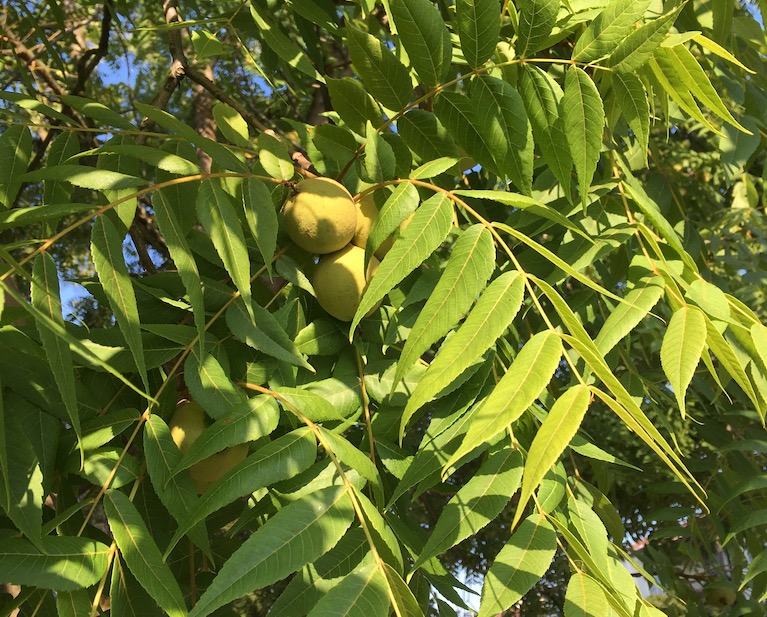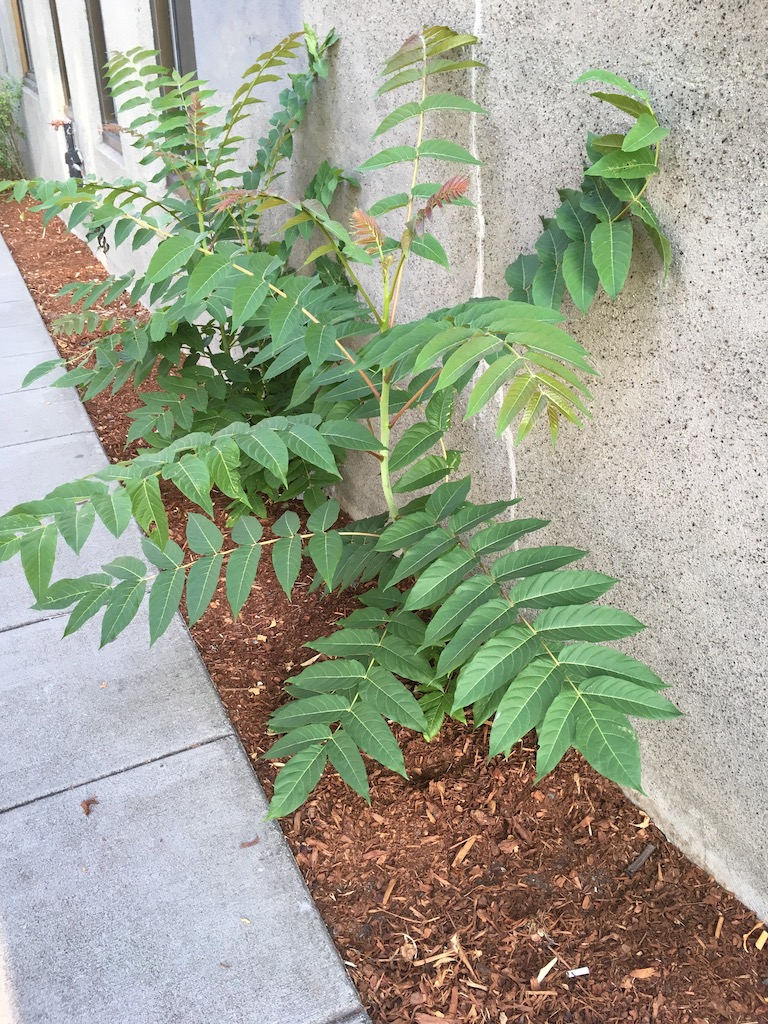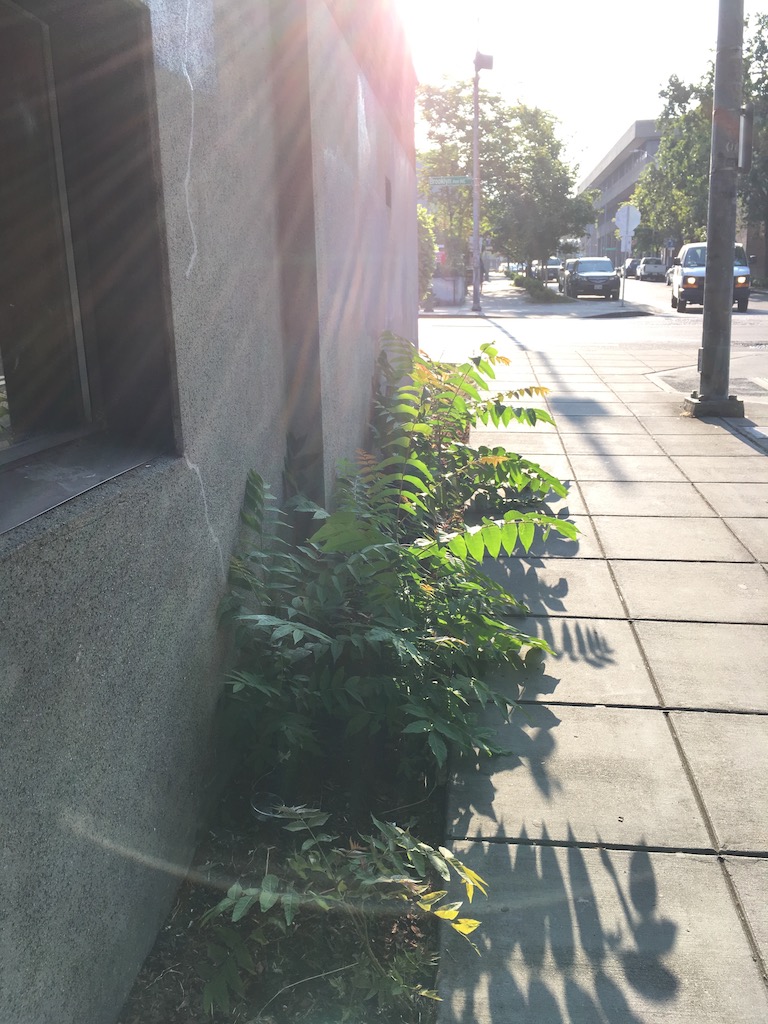Walking down a Seattle street, in the University District, on a glorious summer morning, I pass by the south side of Levere Apartments, a classic 1920s apartment building. The narrow strip of soil beside it has been densely planted with something that almost seems to be growing into a hedge.
The leaves look familiar. Pinnate, with serrated ovate leaflets. Could it be Juglans nigra, the Eastern Black Walnut?
But what is a species that can grow to 100 feet doing, growing here? It cannot become a hedge. These little plants are going to want to grow tall, their roots are going to compete with the foundation of the building, and if they manage to reach maturity, they will bear large nuts that stain the sidewalk.
And they couldn’t have just flown in on the wind. The only way to grow a black walnut tree is to plant the nut in the ground. The nuts are big. After they fall, they might roll around a bit, but not far enough and not in enough numbers to explain what we see here. They had to be brought there, and buried intentionally. What kind of landscaper would do this?
The squirrelly kind, that’s who. Problematic plantings like this are often the work of the Eastern gray squirrel.

Street life
I lived in Seattle for a good number of years, and across the alley from my walkup apartment on a commercial strip in the University District, there was a big black walnut tree growing in an unpaved patch next to a dumpster. As it playfully dropped nuts on cars parked underneath, it also fed a multitude of squirrels. Every spring in its greening boughs it welcomed what seemed to be the same American Robin, returning every year; and its bare winter branches would host a chattering Northern Flicker.
The tree is gone now, like most of what I once loved about the city — murdered by somebody’s monstrous, seven-story property investment, whose claim to existence has inevitably been affirmed by hordes of oblivious, complicit tenants, who the investors knew would come clamoring to rent there.
But that tree’s offspring were already everywhere. Every summer, they would start sprouting at the base of the Stop sign at Brooklyn and 42nd, in a crack in the sidewalk on 42nd, and against the foundations of random houses and buildings. Some would get to be ten feet tall before a landscape crew or the city would get around to removing them. One or two managed to find a sufficiently neglected spot that it would become mature and bear nuts, like the one that still lives on the south side of the block of 42nd between 11th and 12th, where the nuts pictured above were growing, and presumably, the one across the alley.

Squirreled away
These are the places a squirrel would naturally select to bury a nut. Foundations are attractive because they often are landscaped with soft mulchy soil, placed there by the gardener to prevent weeds and shrubs from growing, but providing no defense against a vigorously sprouting walnut. Signposts are attractive too, because they often have some soft earth at the base of the sign where weeds have been suppressed by herbicide. Earthy gaps where a sidewalk has broken are often good for similar reasons.

Strength in numbers
I am told that somehow, Eastern gray squirrels (Sciurus carolinensis) have colonized Seattle and largely displaced the native squirrels. Unlike the proverbial image of hoarding hundreds of nuts in a hollow tree, Eastern gray squirrels bury nuts individually, and it’s been shown that they rarely if ever remember where they buried any of them. In the fall, they become very busy burying nuts in places where a squirrel would bury a nut – wherever there is a soft soil and a bit of cover. When winter comes and they get hungry, they probably start thinking, “Now where would I bury a nut, if I had a nut?” And then they randomly happen to find some of the same spots that this or another squirrel previously selected, perhaps aided also by scent.
You can only win this game with numbers — the more nuts you bury, the more likely you’ll recover enough of them to survive. Many of the stashed nuts, possibly the majority, are never found at all, and they end up either rotting or growing into trees.
So it seems that the evolutionary survival mechanism of “squirrels burying nuts” cannot be fully understood unless we consider that it has the effect of not only stashing food for the winter, but also propagating the very trees that provide that food. The squirrel has no idea that it’s doing this. Its short-lived memory suggests that it barely even knows that it’s storing food. But it works. That’s evolution — successful function, free of intent, but loaded with effectiveness.
Similarly, it is a favorable coincidence that the Eastern gray squirrel, and the Eastern black walnut, both moved West and then reunited, like two old friends who moved to a new city and, through their mutual compatibility, happened to find each other again.
Sidewalk botany
Which brings us back to those mysteriously misplaced saplings along the foundation of Levere Apartments. Are these vigorous saplings, and their eight to ten companions not pictured, the future black walnut orchard of a diligent squirrel?

For a long time, I was sure of it. I even posted a version of this article that blithely asserted so, on the strength of my own long experience of regularly spotting actual walnut saplings growing in the same manner along similar foundations, including some that were mature enough to start bearing nuts. But then, an actual botanist read that article, and politely questioned my identification. It was quite obvious to her, on closer examination of the leaves, that this was not the genteel but occasionally misplaced Eastern black walnut, but the insidiously invasive Ailanthus altissima, or Tree of Heaven.
Had I bothered to sniff the leaves when I took the pictures, I would have known instantly — Ailanthus has a horrible scent that affirms its unwanted presence. But I had sniffed so many black walnut leaves in seasons past, that I rested on my laurels. No, these seedlings that so enraptured me that day are not black walnut, exactly — but as body doubles, they illustrate very well how Juglans nigra, through its partnership with the Eastern gray squirrel, achieves its habitual misplantings. And since an Ailanthus can grow about as tall and massive as a Juglans, it shows that now there are two errant tree species that plague the works of man in this and many other neighborhoods. After we humans are gone, it may be Juglans nigra, Sciurus carolinensis, and Ailanthus altissima that first start our structures tumbling down.
Mistaken identities
This episode of misbegotten botany reminds me of a time when a woman I knew, who was a landscape architecture student, looked out of my apartment window and saw that big walnut tree across the alley, and confidently accused it of being a Tree of Heaven. I had seen it dozens of times from the same window, and had been calling it a Black Walnut, so I was a bit disappointed by her assessment, but she knew her stuff, so I accepted it — until, later that year, it started dropping nuts on my car.
As my “actual botanist” friend likes to say, “You cannot do botany from a car.” Nor, I would add, from a bedroom window.


